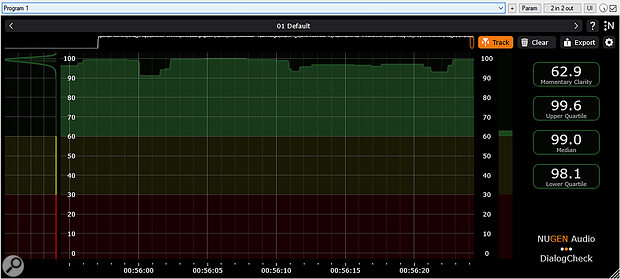 A screenshot of the DialogCheck GUI after playing through a podcast interview of clean and perfectly intelligible dialogue. Note the very high median clarity value, and the narrow range between the upper and lower quartiles. The consistency of clarity is also shown in the statistical distribution graph on the left‑hand side.
A screenshot of the DialogCheck GUI after playing through a podcast interview of clean and perfectly intelligible dialogue. Note the very high median clarity value, and the narrow range between the upper and lower quartiles. The consistency of clarity is also shown in the statistical distribution graph on the left‑hand side.
The problem of dialogue intelligibility has proven a stubborn nut to crack — but this new meter promises to make consistently clear voices easier to achieve...
The intelligibility and/or clarity of speech is quite obviously of paramount importance in almost all audio‑programme content, whether that’s film, TV, radio, podcasts, YouTube and TikTok videos, computer games... or whatever. Unfortunately, poor‑quality dialogue remains a primary cause for complaint amongst broadcasting and streaming viewers and listeners — after all, it’s impossible to enjoy a programme (or to convey useful information to a listener) if the speech is hard to follow.
Since we all know, intuitively, whether dialogue is intelligible or not — we can either understand the words easily, or we can’t — it might seem like it should be easy for programme makers to judge. Yet, speech intelligibility can actually be quite hard for them to assess, and this is the problem Nugen aim to address with their DialogCheck plug‑in. But before I start exploring the plug‑in itself I’d like to discuss the complex nature of the problem in a little more detail.
Quantifying The Problem
A key reason for the difficulty in judging intelligibility is that key production staff will typically spend weeks or months working with the script before filming or recording — so, even if a performer mumbles their lines, they already know what they are supposed to be saying. Sound recordists typically follow a script too, so, again, poor diction can easily go unnoticed because the brain, primed by the script, automatically ‘fills in the gaps’.
When it comes to post‑production, either poor delivery during the recorded scene or a mix with heavy effects or music may well seem perfectly intelligible to the post‑production crew, too — not only because of their prior knowledge and familiarity with the content, but also because they’re auditioning it using high‑quality monitoring equipment in acoustically treated listening environments, and enjoy the spatial separation afforded by multi‑channel speaker systems. Casual viewers/listeners, on the other hand, are new to the production, so they don’t have that prior knowledge of the script, and they’re also unlikely to be listening to high‑quality loudspeakers in a good acoustic environment. Worse still, they probably have to contend with all manner of background domestic noises that can mask the dialogue or distract their attention.
Although some of these impediments to speech intelligibility are far beyond the control of the programme creators, many elements within the production process can be controlled. And the first step in optimising speech clarity is being able to quantify it — accurately, reliably and repeatedly — both in its raw state when being captured, and in the context of a full production mix.
So, the fundamental question to answer is: how can we quantify speech intelligibility? And that’s a conundrum that’s been exercising the minds of clever people for some time. Some of the answers have come from Fraunhofer IDMT, who have developed a solution called the ‘Listening Effort Meter’. It’s a technology that combines automatic speech recognition with psychoacoustic modelling, and is powered by twin AI neural networks. During its...
You are reading one of the locked Subscribers-only articles from our latest 5 issues.
You've read 30% of this article for FREE, so to continue reading...
- ✅ Log in - if you have a Digital Subscription you bought from SoundOnSound.com
- ⬇️ Buy & Download this Single Article in PDF format £0.83 GBP$1.49 USD
For less than the price of a coffee, buy now and immediately download to your computer, tablet or mobile. - ⬇️ ⬇️ ⬇️ Buy & Download the FULL ISSUE PDF
Our 'full SOS magazine' for smartphone/tablet/computer. More info... - 📲 Buy a DIGITAL subscription (or 📖 📲 Print + Digital sub)
Instantly unlock ALL Premium web articles! We often release online-only content.
Visit our ShopStore.
